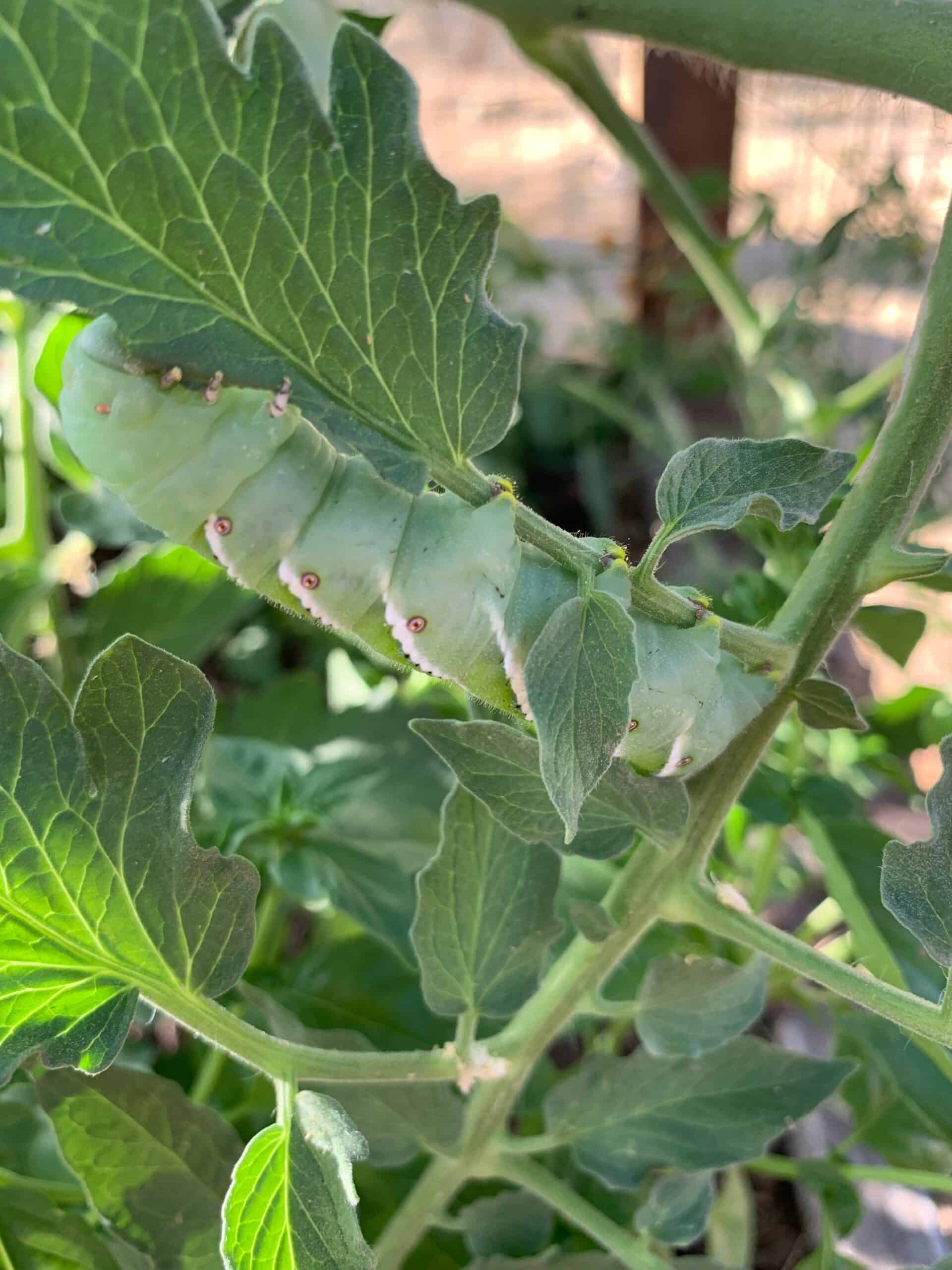Tomato hornworms and tobacco hornworms will wreak havoc on your garden. You may first realize you have a problem when you see bite marks on leaves along with leafless stems on your tomato plants. Damage control is the first thing you need to do. We explain how to get rid of tomato hornworms easily and for good.
It’s a game of I Spy when you realize you have tomato worms or tobacco worms. Inspect the plants that have the most damage. It will take a while to find them but you will. Remove all the caterpillars so they don’t eat away more of your plants. If you don’t remove them, they may completely defoliate the plants.
Even after applying treatment, keep looking for them for several days. You’ll have the best luck finding them early in the morning and at dusk. After you’ve removed as many as you can find, spray with the organic pesticide Bacillus thuringiensis (BT) (which is what I used and it worked right away) or a mixture of dish soap and water.
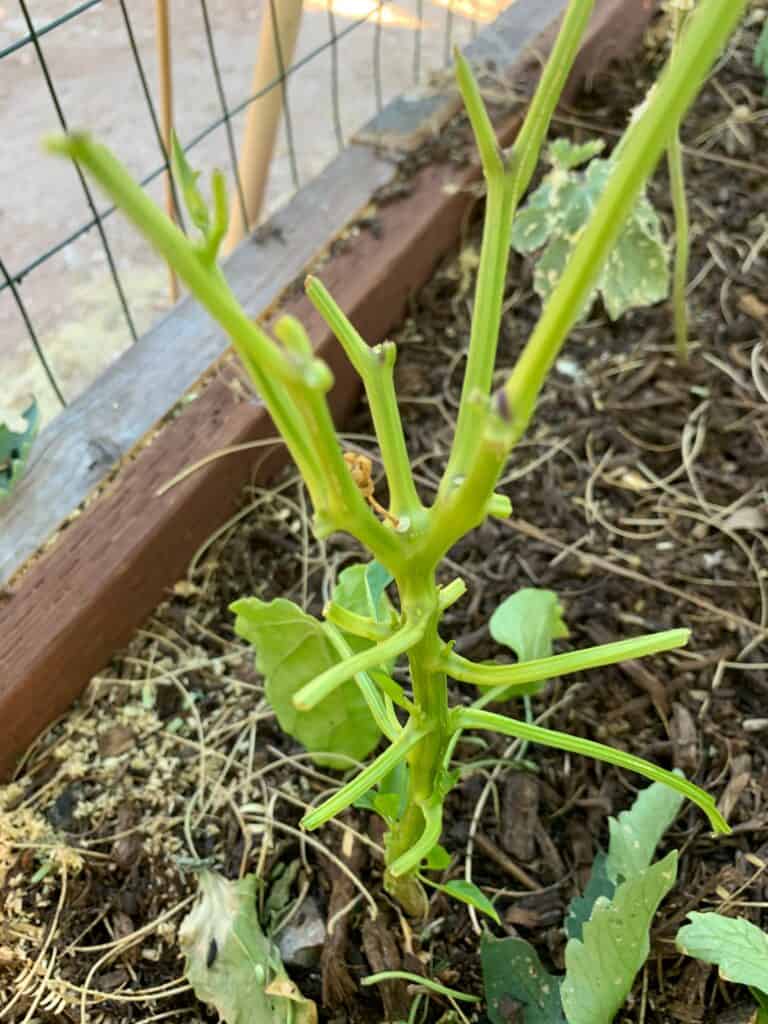
Keep reading to learn how to get rid of tomato hornworms to prevent them from eating away your tomato plants as well as eggplant, potato, and pepper plants. Also, learn control tips and preventative measures for future gardening endeavors.
You don’t want big green caterpillars eating away your plants, so whether you have tomato hornworms, tobacco hornworms, or both, you can treat them the same. Eliminate them!
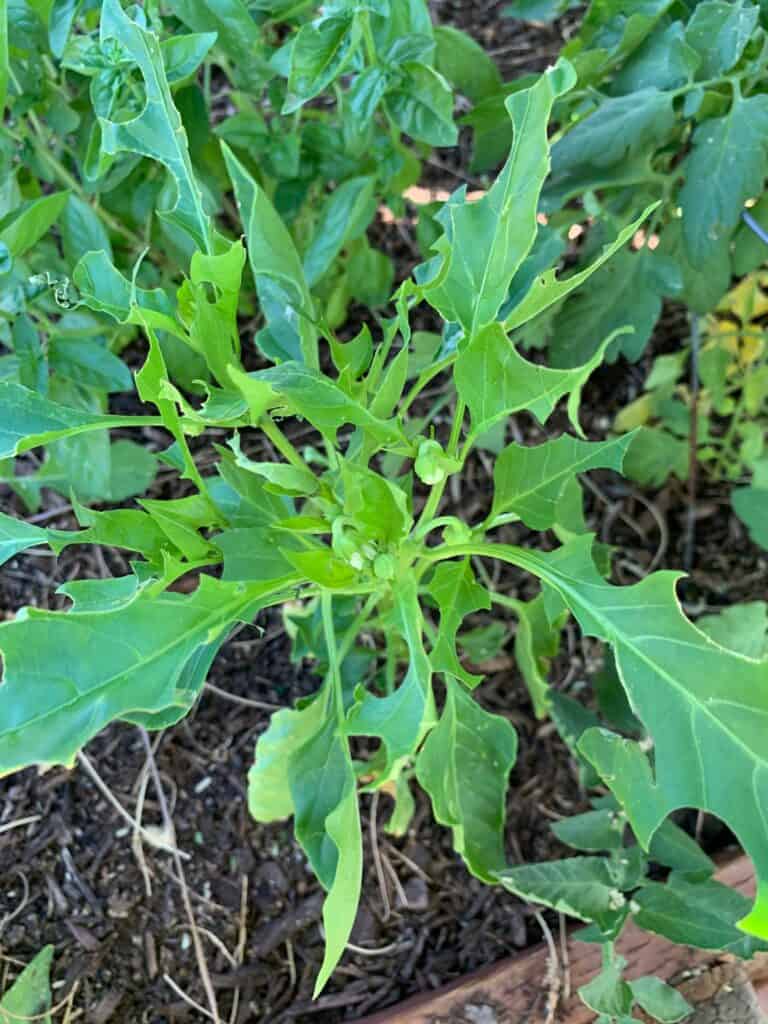
Are Tomato Worms Eating My Tomato Plants and Pepper Plants
Despite tending my garden every evening for months, I was stunned I didn’t notice a hornworm problem until significant damage was done. My tomato plants are large and vining and several are bushy. I was growing 12 tomato plants and 6 pepper plants in two raised garden beds.
These garden pests did significant damage on 3 tomato plants and 2 pepper plants and noticeable damage on another 7 tomato plants and one pepper plant. The hornworms found their way to both garden beds.
I started looking for the hornworms where the most damage was and where their poop was.
When I first saw a tomato hornworm, I couldn’t believe how large it was. The hornworm larva is several inches long. Even more, it was shocking to see how well it blended into the plant. It was hard to spot them at first. However, once I knew what I was looking for, I found 8 hornworms that first evening.
The next morning, I found another 3 and then another 4 that evening. By this time, I was getting a bit braver at removing the caterpillars because I wanted to save my garden but I was still squeamish.
Signs of Tomato Hornworms
Any of these can mean you have tomato hornworms or tobacco hornworms in your garden:
- Growing nightshade plants (tomatoes, peppers, potatoes, eggplant)
- Stems with leaves missing and/or chewed leaves
- Stems that are defoliated
- Black or dark green droppings near where there are chewed up or missing leaves
- Eggs on the underside of tomato leaves or on the leaves of other nightshade plants
- Large green caterpillars
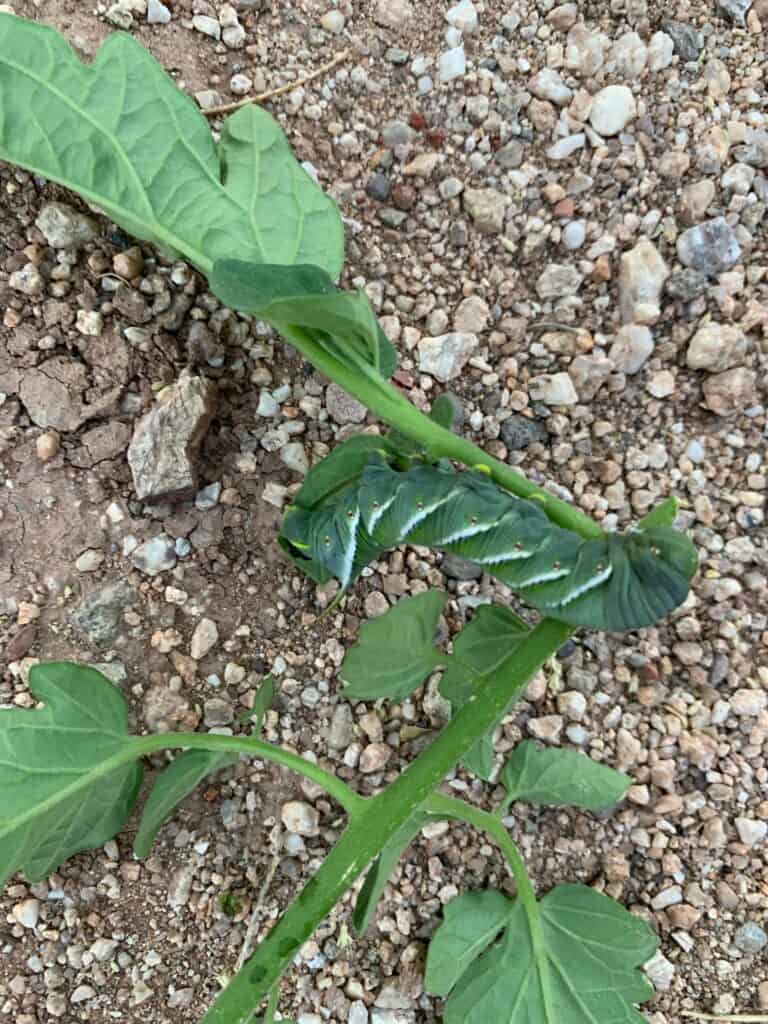
How to Get Rid of Caterpillars on Tomato Plants
Use these steps to remove tomato hornworms from your plants. You’ve done the difficult job of locating these hard-to-find green caterpillars.
When you do find one, you may be surprised at how large they are and how you didn’t see them easily. They can be 5 inches long! They blend into the foliage, especially if you have lush tomato plants. You’ll really need to hunt for them.
While they will defoliate and destroy your plants, the good news is they won’t sting or bite you. This means you can handpick them if you want to.
How to pick hornworms if you are brave:
- Use a pair of gardening gloves, work gloves, or disposable gloves if you have them. Gloves make the unpleasant task of removing tomato hornworms easier for some people. However, they are not necessary if you aren’t squeamish about touching hornworms.
- Remove the tomato hornworm from the plant. It may be hard to remove at first as it sort of latches on to the stem.
- Decide what to do with the hornworm. Feed hornworms to chickens if you have them. If you don’t, you can smash them and toss them in the compost or trash. Or you can squash them and leave them on the ground; likely within minutes, the ants will come marching and eat them. If you want to leave them out somewhere away from your garden, birds may find them and eat them.
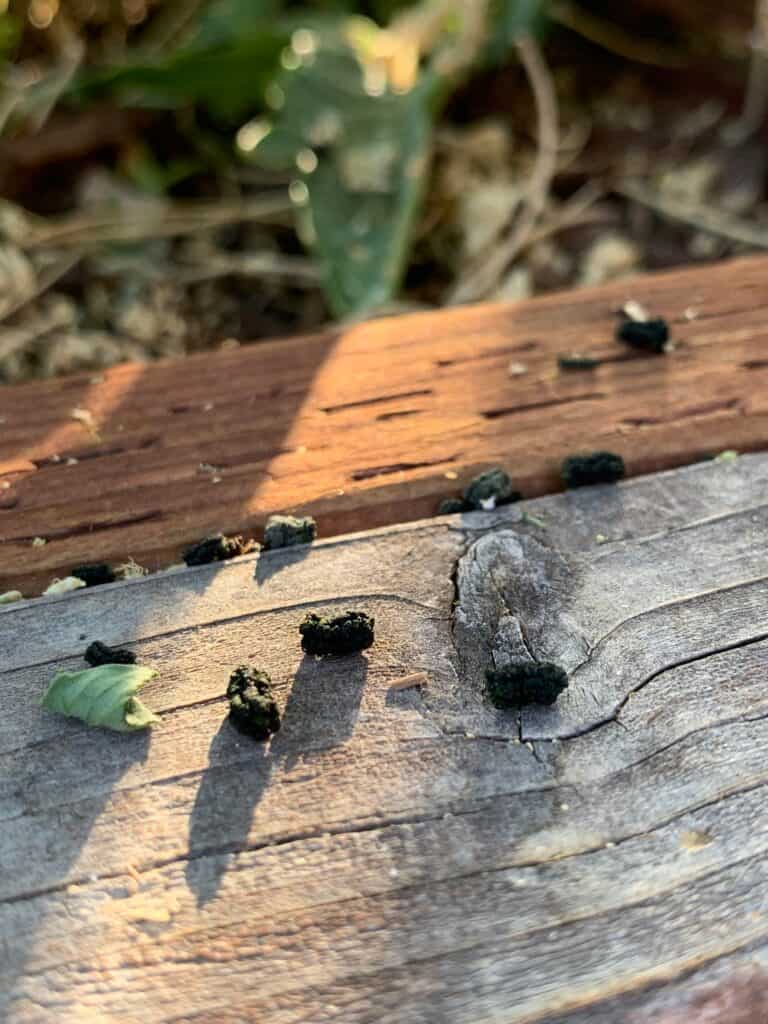
How to pick tomato hornworms if you aren’t brave (like me) and don’t want to touch the tomato worm:
- Use tongs to remove the hornworm from the tomato plant. As gross as this is, I used metal kitchen tongs because that’s all I had. They worked great.
- Relocate the worm to the ground somewhere away from your garden.
- Ask someone braver to crush it (or do it yourself) or give it some tomato leaves to feast on and wait for the birds to find it. They make a great treat for chickens.
How to Get Rid of Tomato Hornworm
I read about using cayenne pepper mixed with dish soap and water and liked that it was a natural remedy. I didn’t have cayenne pepper but I had chili powder so I called a well-respected local nursery in town and asked if I could substitute chili powder for cayenne.
The person at the nursery said the only thing that works to get rid of tomato hornworm is to use Bacillus thuringiensis, called BT. He said it is a natural chemical. Another thing he said is that pepper (cayenne, chili pepper, etc.) will not be effective to treat tomato hornworms because peppers only affect mammals.
I compost and enrich my soil with peat moss, vermiculite, and compost. I never use fertilizer or insecticides so I was hesitant to use a chemical, even if it was natural.
So I called another local garden center in my town and the expert at the help desk told me the same thing. The person also said to spray it any time of day. I waited until dusk because I live in gardening zone 9b (southwestern United States) which has very hot spring and summer afternoons.
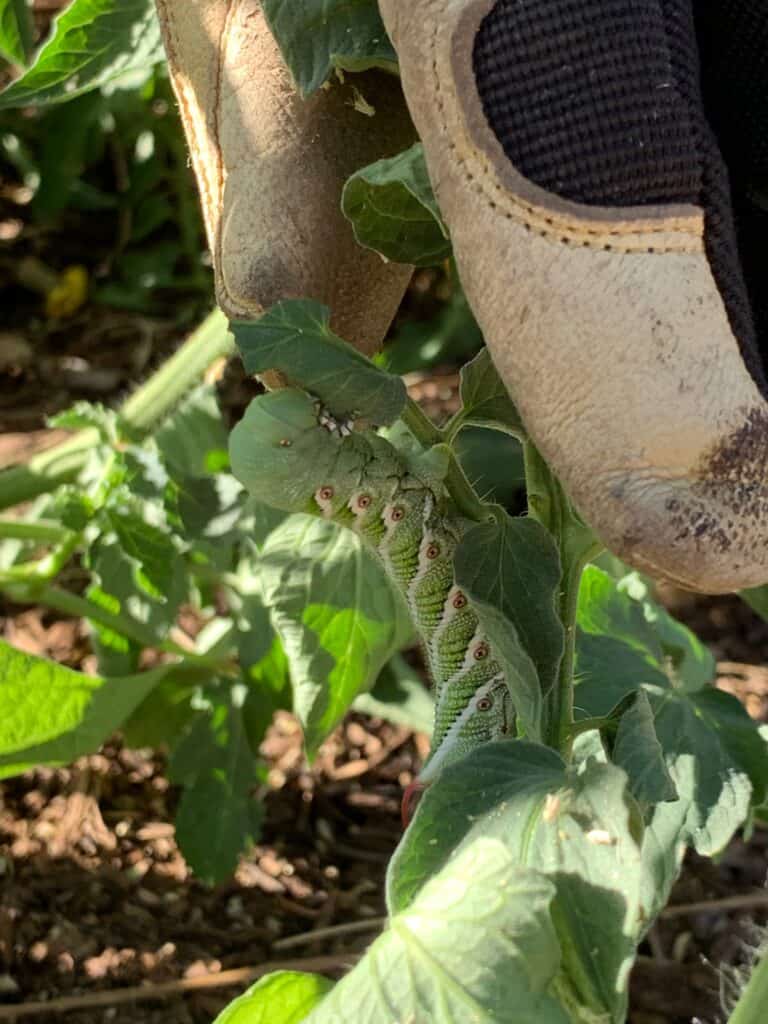
Using BT to Eliminate Tomato Worms
So I went to the closest store to my home that carried it (ACE Hardware) and bought a bottle of Bacillus thuringiensis aka BT. You can also buy it at garden centers, nurseries, home improvement stores (Home Depot, Lowe’s, Menards), etc. I already had a spray bottle.
Following the directions on the container, it was easy to mix and use. I poured the BT liquid and diluted it with water in a clean spray bottle. Then, in the evening, I went out to my garden and found 2 more hornworms which I removed.
Afterward, I sprayed the BT and water mixture on all of my pepper and tomato plants. I tried getting the leaves and stems as best as I could. I didn’t intentionally spray the tomatoes and peppers that were growing.
By no means did I saturate the plants but it worked. To be effective, it must be ingested by the caterpillars. Despite looking for those pesky green hornworms for several days, I never saw one again. However, I did see a dried-up one that must have come in contact with the BT.
I only needed to spray one time. If you have rain, it is important to reapply BT. So from my personal experience and from both of the nursery experts, you may want to use BT to get rid of hornworms. According to the Minnesota Department of Health, BT operates through a well-known protein mechanism that causes toxicity in caterpillars (i.e. insect larvae).
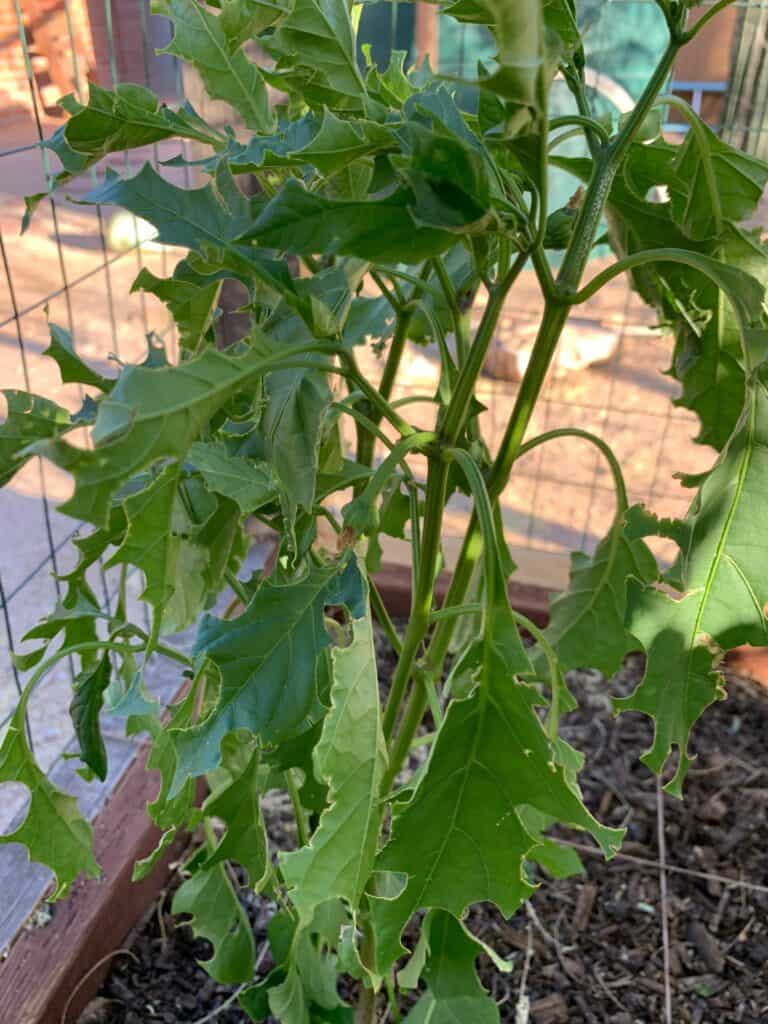
Farmers and home gardeners use BT as an alternative to chemical pesticides. Bacillus thuringiensis:
- Is a naturally-occurring bacteria commonly found in soil and food
- Acts as a stomach poison on some larval insects without harming other things
- Has been used for decades safely to control insects in North America
Just as we should wash all fruits and vegetables we grow and buy, be sure to wash the tomatoes and peppers well before eating them.
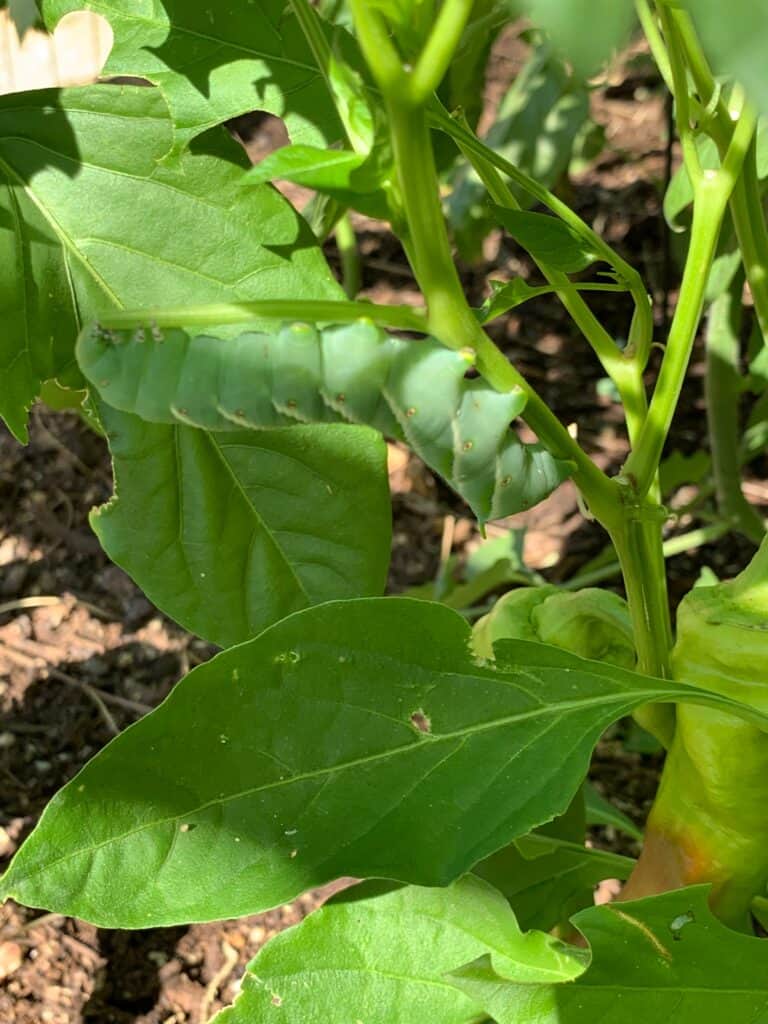
How to Use BT to Get Rid of Tomato Hornworms
Here are the steps to recap what I discussed above:
- Gather clean spray bottle and BT.
- Follow instructions on the BT bottle and mix with the appropriate amount of water.
- Gently shake.
- If possible, apply to your plants as soon as you notice signs of infestation.
- Spray BT on the nightshade plants in your garden. Spray on the leaves and stems.
- Reapply after rain.
How to Get Rid of Tomato Hornworms Naturally
Here are some natural ways to eliminate these green tomato worms from your home garden.
- Handpick or use tongs to remove the caterpillars.
- In mid-spring, look for tomato hornworm eggs on the underside of foliage and remove the leaves.
- Mix water and Bacillus thuringiensis, a natural, organic bacterium, also called BT, and spray the plants.
- Combine dish soap liquid and water and spray on plants. Immediately afterward, while the leaves, stems, and fruits are wet, sprinkle cayenne pepper on the plants. (The garden expert at the nursery said cayenne won’t repel hornworms but if you want to try it, go for it!)
- Spray dish soap and water mixture (without using cayenne).
- After the gardening season and before planting for the next season, be sure to till the soil.
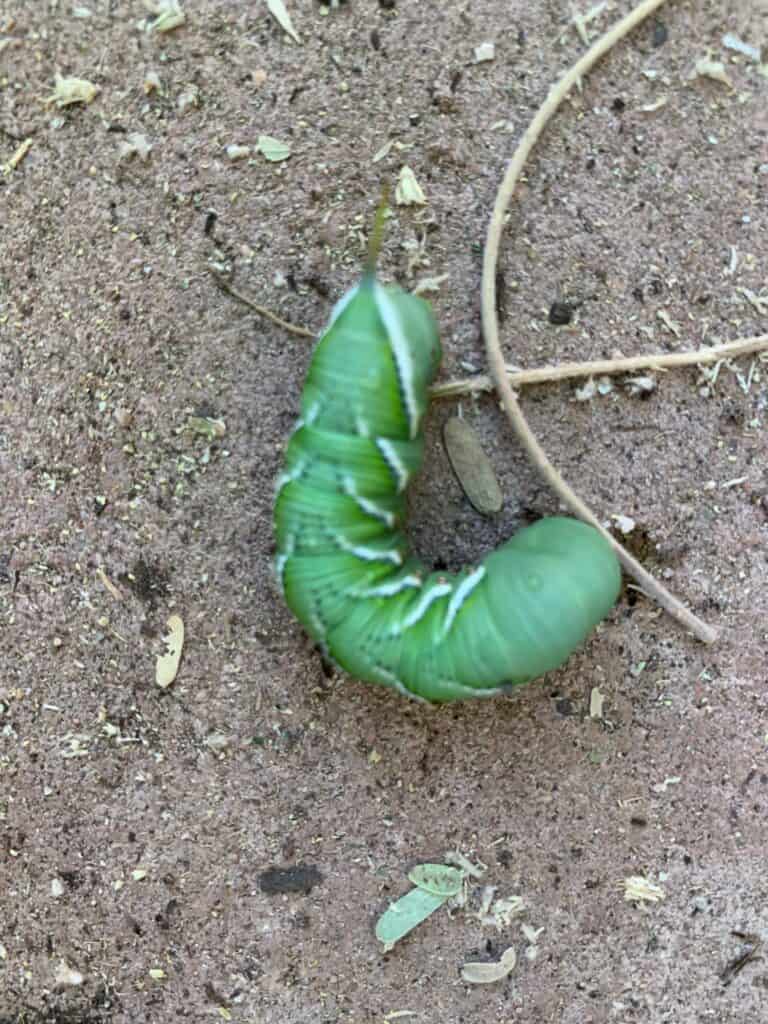
What to Do With Tomato Hornworms
Squish them:
After handpicking the tomato hornworms, you have to do something with them. While some recommend dropping them in a bucket of water or a bucket of soapy water, my opinion is there are better ways. If you can do it, smash it with your shoe. My view is that squishing them is “better” than drowning them as it seems more humane.
Toss in compost, or trash, or leave them on the ground:
Smash them, and put them in the compost or trash. Be sure to not put alive tomato hornworms in the compost tumbler or compost pile. Or you can step on them and leave them for ants to find.
Feed to chickens or leave for birds:
If you have chickens, you can feed tomato hornworms to them. Another option is to wait for the birds to get them. While these options may not be as humane as smashing them, at least they are providing food and not going to waste.
What are Tomato Hornworms
Tomato hornworms, Manduca quinquemaculata, are green caterpillars (larva) that are thick and several inches long. You will know they are tomato hornworms from their appearance. They have V-shaped white and black markings and stripes on their bodies as well as a black horn-looking extension on the back. These hornworms blend in well and aren’t always easy to spot.
They are common in home gardens. The larva feeds non-stop on plants in the Solanaceae family. These are nightshade plants which include tomato plants, peppers, eggplant, and potatoes. One day you have thriving plants and the next, you notice just stems where leaves once were.
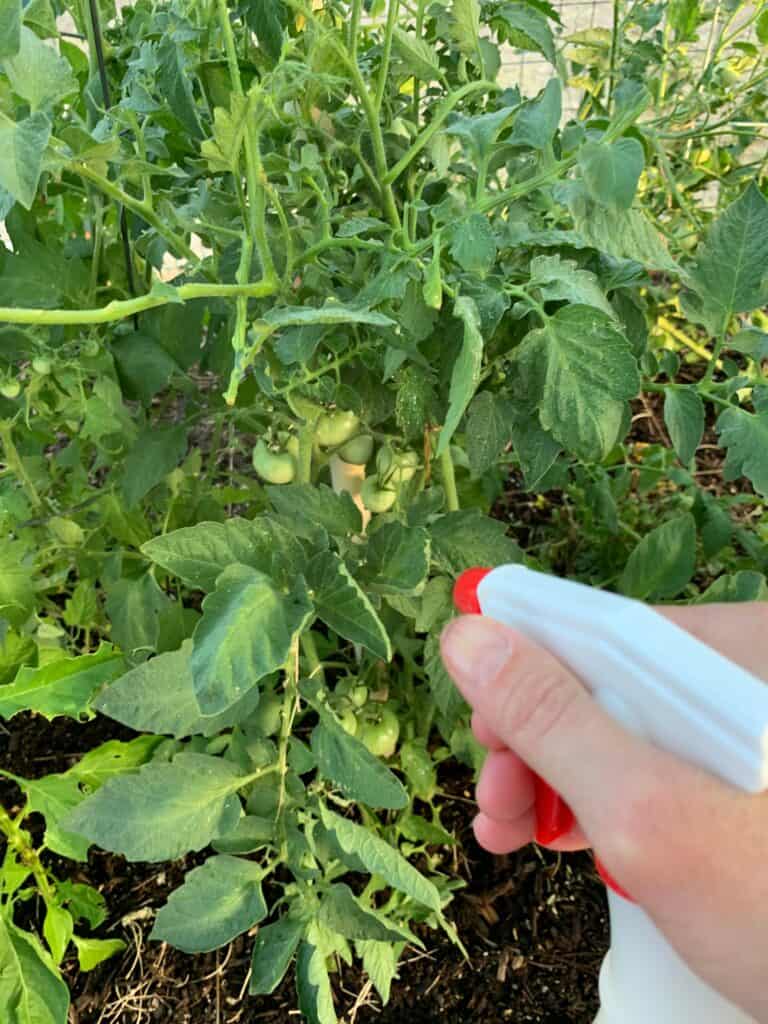
Tomato Hornworms vs Tobacco Hornworms
Tomato hornworms are different than tobacco hornworms (Manduca sexta) though both are green caterpillar pests that will destroy tomato plants in home gardens. Tobacco hornworms have a red horn instead of a black one. Also, instead of a V-pattern on their bodies, tobacco worms have parallel white stripes with black spots along the lines.
Tomato Hornworm Lifecycle
The hornworm larva turns into what is commonly known as a sphinx moth or a hawk moth, some of the largest moths in the world.
Eggs
Adult moths lay eggs in the garden, underneath the leaves, in the late spring. The tomato hornworm eggs take a week to hatch into caterpillar larvae.
Caterpillar Larvae
The larvae will feast in gardens for a month to 6 weeks. They do the most damage in the larvae stage and can grow to be 5 inches long. After this time, they make a cocoon and overwinter in their pupal state in the garden soil. Depending on the temperature, the larvae burrow for a minimum of 2 – 3 weeks.
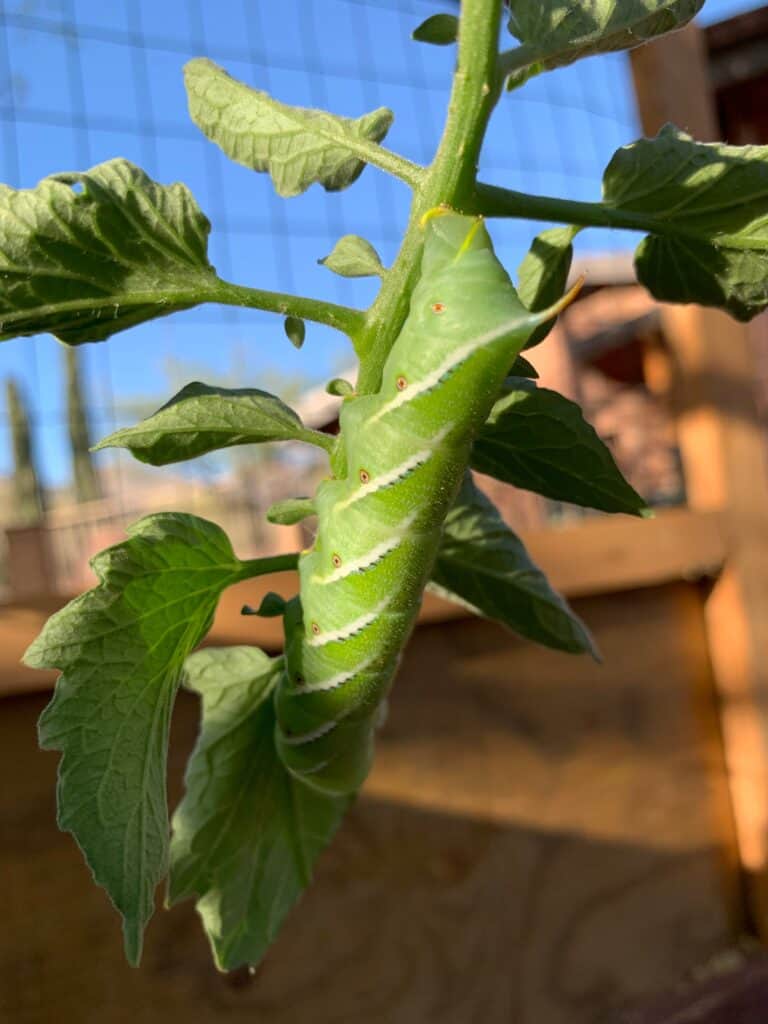
Moths
The moths emerge from their cocoons in the spring. They lay eggs and continue the cycle.
How to Prevent Tomato Hornworms
There are many things you can do to prevent and control a future tomato hornworm infestation on your garden nightshade plants.
1. Weed your garden.
The fewer plants that are around, the easier it is to spot them. Weeding also provides fewer spots for hornworms to lay their eggs.
2. Regularly inspect your nightshade plants for eggs, caterpillars, and signs of damage.
Look for chewed or missing leaves. If you see leafless stems, you may have a tomato worm problem. Act immediately by finding and removing the hornworms.
3. Cage indeterminate tomato plants, and keep them from spreading to nearby plants.
When you have thick foliage with lots of branches touching other plants, it’s difficult to notice if tomato hornworms are eating your plants. Cage the tomato plants, and try to give more space to each of your plants.
4. Plant companion plants among the nightshade plants to repel moths.
Try not to put tomato plants and pepper plants next to each other. Add some companion plants such as marigolds, basil, and dill. The moths that lay the eggs that hatch into tomato worms do not like these plants.
5. Plant a variety.
Plant a variety of plants so there is spatial and temporal diversity to attract beneficial insects.
6. Release beneficial insects such as lacewings or ladybugs into the garden.
Ladybugs and green lacewings are beneficial insects that can help control the tomato hornworm population by eating their eggs and young hornworms.
7. Till the soil at the end of the gardening season and before every new planting.
Churning up the soil will help to destroy overwintering larvae.
8. Grow tomatoes and nightshade plants in pots.
Growing tomatoes in pots is another way to minimize tomato hornworm infestation. I have two large pots and grew tomato plants in each one. I never had a problem with tomato hornworms.
Growing determinate tomatoes in pots is better than indeterminates because determinates grow bushier and are easier to stabilize with stakes or a tomato cage in a pot.
9. Grow nightshade plants in hydroponics.
Another option is to learn how to grow hydroponic tomatoes. Being the caterpillar larva overwinters in the soil, they won’t be able to in a liquid growth medium. This isn’t to say moths won’t lay eggs on the leaves; however, they may be less likely to than if they were in a soil garden.
FAQs
How do I get rid of tomato hornworms naturally?
Handpick or use tongs to remove tomato hornworms. When there is hornworm, there are more, so keep looking for them. As you continue to look in the morning and the evening for several days, you can also spray BT, (Bacillus thuringiensis) a bacterium naturally found in soil. It is a bacterial organic pesticide.
What kills hornworms on tomato plants?
You can mix liquid BT with water and spray it on the tomato plants, including the top and bottom of the leaves and stems. It’s best to remove the hornworms you see, and then spray.
How do I keep tomato worms off my tomato plants?
There are several things you can do to keep tomato worms off tomato plants. Space plants so they aren’t touching each other as they grow. Weed the area thoroughly. Use companion plants that naturally repel tomato hornworms, such as dill, basil, and marigolds.
Be sure to till the soil after the growing season and before the next planting season. Another idea is to grow tomato plants individually in pots or hydroponics.
Will tomato plants recover from hornworms?
Depending on how much damage is done, tomato plans can recover from hornworms. Inspecting tomato plants regularly and catching any signs of hornworms sooner rather than later is best. Also, if the hornworms start feeding on larger, more established plants vs smaller, newly-planted tomato plants, they have a better chance of recovering.
Can a tomato hornworm hurt you?
No, tomato hornworms won’t hurt you as they don’t bite or sting. They aren’t venomous or poisonous. However, they are a garden pest that will destroy tomato plants, pepper plants, and other nightshades.
What does a tomato hornworm turn into?
A tomato hornworm caterpillar turns into a sphinx moth or hawk moth.
Can you touch tomato hornworms?
You can touch tomato hornworms. Gently pull them to remove them from your plants. You can use your bare fingers to touch them or use gloves. They won’t bite or sting you though they will wriggle around.
Should I remove tomato hornworm?
Yes! You should immediately remove a tomato hornworm when you see one. If there is one tomato worm, chances are, there are many. Look for them around plants and move them away from your garden. Hornworms are sometimes difficult to remove from tomato plants because they sort of latch on.
Are hornworms dangerous?
Hornworms aren’t dangerous to humans but they are dangerous to your plants. They will feed non-stop and eat away your tomato plants and other nightshade plants until you remove them and treat them with BT or another natural remedy. While they will attack your plants, they aren’t harmful to people.
Are tomato hornworms poisonous?
No, tomato hornworms are not poisonous nor are they venomous.
Do tomato hornworms bite?
No, tomato hornworms don’t bite. They are safe if you want to handpick them off your plants. You can toss them to your chickens safely as well.
Do tomato worms turn into butterflies?
Tomato hornworms turn into hawk moths or sphinx moths while tobacco hornworms turn into hawk moths or hummingbird moths. These are all large moths — about 5 inches. You may think it’s a bat or a hummingbird when you first see them fluttering around.
How to Get Rid of Hornworms
Learning how to get rid of tomato hornworms is essential to keep your garden intact. You’ve worked hard on it, and it costs time and money to have a garden. Treating hornworms as soon as possible is important so they won’t eat away at your plants.
Tending to your garden regularly and being aware of the signs of tomato hornworms will help you stay on top of it should you have them. If you notice signs of hornworms, such as missing leaves and partial leaves that were chewed, start looking for them on your plants.
They are hard to spot as the caterpillar’s green is camouflaged on the tomato plants’ green foliage. Pick all of them, and remove them from the garden. Keep looking for them for a few days. They can be difficult to spot!
After contacting local nurseries who both told me to use Bacillus thuringiensis, BT, which they assured me was natural, I was glad I did. According to one of the professionals, he said cayenne pepper will not be effective to treat tomato hornworms because peppers only affect mammals.
It was easy to apply — I didn’t even use that much — and it eliminated the hornworm problem.

